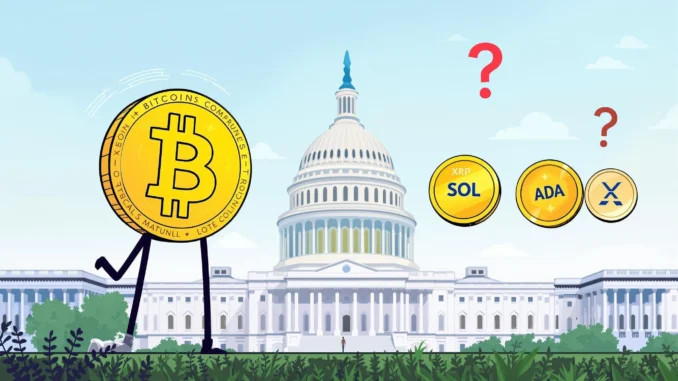
The idea of a national crypto reserve in the United States has sparked considerable debate, especially after former President Donald Trump’s recent statements. While the concept gains traction, financial analysts at Bernstein are raising pertinent questions, specifically about the inclusion of altcoins alongside Bitcoin. Is it a strategic move or a misstep? Let’s dive into Bernstein’s analysis and understand the complexities.
Why is Bernstein Questioning the Altcoin Crypto Reserve?
Bernstein, a well-respected asset management firm, recently voiced skepticism about the rationale behind including cryptocurrencies beyond Bitcoin in a national crypto reserve. In a note released on March 3rd, Bernstein analysts highlighted a crucial distinction: Bitcoin’s established position as “digital gold” provides a clear justification for its inclusion. However, the same logic doesn’t automatically extend to other cryptocurrencies like Ethereum (ETH), XRP, Solana (SOL), and Cardano (ADA).
Here’s a breakdown of Bernstein’s core arguments:
- Bitcoin’s Unique Status: Bernstein acknowledges Bitcoin’s distinct role as a store of value, often compared to gold in the digital age. This “digital gold” narrative makes a strong case for Bitcoin’s inclusion in a national reserve, aiming to diversify assets and potentially hedge against economic uncertainties.
- Ambiguity Around Altcoins: The analysts question the strategic rationale for holding altcoins in a national reserve. Unlike Bitcoin, the justification for these cryptocurrencies is less clear-cut in the context of a national strategic asset. Are they stores of value? Are they for specific technological utility within the nation? The purpose remains undefined.
- Central Bank Participation Challenges: Bernstein points out potential challenges if the U.S. central bank were to participate in managing such a crypto reserve. Central banks typically deal with well-established asset classes. Integrating a diverse range of altcoins, each with its own technology, market dynamics, and regulatory landscape, could present operational and risk management complexities.
Trump’s Crypto Reserve Proposal: A Quick Recap
Former President Trump’s crypto stance has been evolving. His recent posts on Truth Social revealed that during his presidency, he issued an executive order directing the Presidential Working Group to explore the formation of a strategic crypto reserve. This proposed reserve, according to Trump, would include not just Bitcoin, but also Ethereum, XRP, Solana, and Cardano.
Trump’s vision, as indicated in his posts, suggests a proactive approach to cryptocurrency adoption and integration into the national financial strategy. However, the inclusion of a broad spectrum of altcoins, as opposed to focusing solely on Bitcoin, is now under scrutiny by firms like Bernstein.
Bitcoin vs. Altcoins in a National Reserve: What’s the Difference?
The core of Bernstein’s argument rests on the fundamental differences between Bitcoin and altcoins, especially in the context of a national reserve. Let’s consider a comparative perspective:
| Feature | Bitcoin (BTC) | Altcoins (ETH, XRP, SOL, ADA) |
|---|---|---|
| Primary Purpose | Store of Value, Digital Gold | Varied: Smart contracts (ETH, ADA), Payments (XRP), Decentralized Applications (SOL, ADA), etc. |
| Market Perception | Established, most decentralized, leading cryptocurrency | Emerging, diverse functionalities, varying degrees of decentralization, higher volatility in many cases |
| Regulatory Clarity | Relatively more regulatory clarity compared to many altcoins in some jurisdictions | Regulatory landscape still evolving, potential for securities classifications in some cases |
| National Reserve Fit (Bernstein’s View) | Strong rationale due to “digital gold” status and store of value narrative | Less clear rationale, purpose in a national reserve needs further justification |
Actionable Insights and Potential Implications
Bernstein’s analysis offers several key takeaways for crypto enthusiasts, policymakers, and investors:
- Focus on Clarity of Purpose: If a national crypto reserve is to be established, clearly defining its objectives is paramount. Is it for hedging, technological advancement, or something else? The purpose will dictate which cryptocurrencies are most suitable.
- Distinguishing Bitcoin and Altcoins: Policymakers and regulators need to recognize the distinct characteristics of Bitcoin versus altcoins. A blanket approach may not be appropriate. Bitcoin’s role as a potential store of value differs significantly from the utility-driven nature of many altcoins.
- Market Volatility and Risk Management: Including a basket of altcoins in a national reserve could introduce higher volatility and require sophisticated risk management strategies, especially if central banks are involved.
- Future of Crypto Regulation: The debate around a crypto reserve highlights the ongoing need for clear and comprehensive cryptocurrency regulations in the U.S. and globally. The regulatory framework will significantly impact the feasibility and composition of any national crypto holdings.
Looking Ahead: The Uncertain Path of Crypto Reserves
The discussion initiated by Trump’s crypto proposal and Bernstein’s critical analysis underscores the complexities of integrating cryptocurrencies into national financial strategies. While the idea of a crypto reserve is intriguing, particularly in a rapidly evolving digital economy, fundamental questions about its composition and purpose remain unanswered. Bernstein’s cautious stance serves as a valuable reminder to approach the concept with strategic foresight and a clear understanding of the diverse landscape of the cryptocurrency market. The future of a U.S. crypto reserve, especially concerning altcoins, remains uncertain, but the conversation is undoubtedly crucial for the trajectory of digital assets in the nation’s financial future.



